
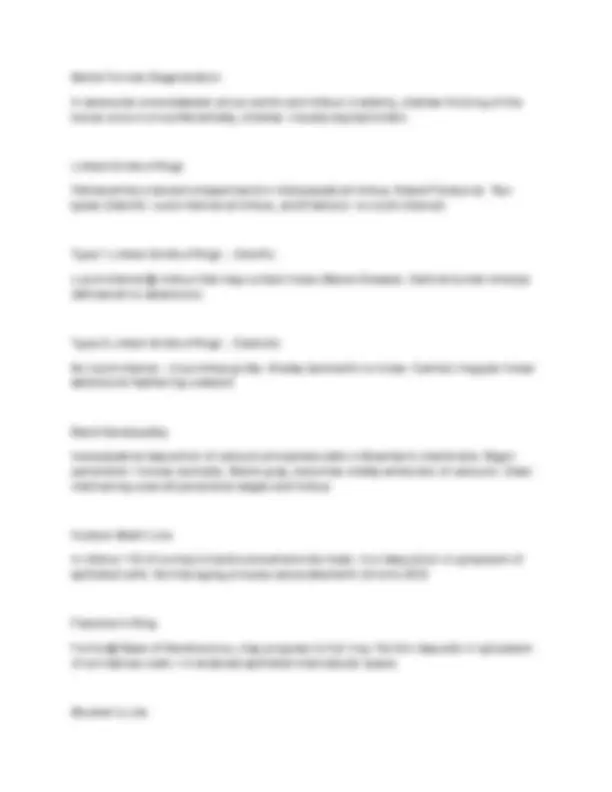
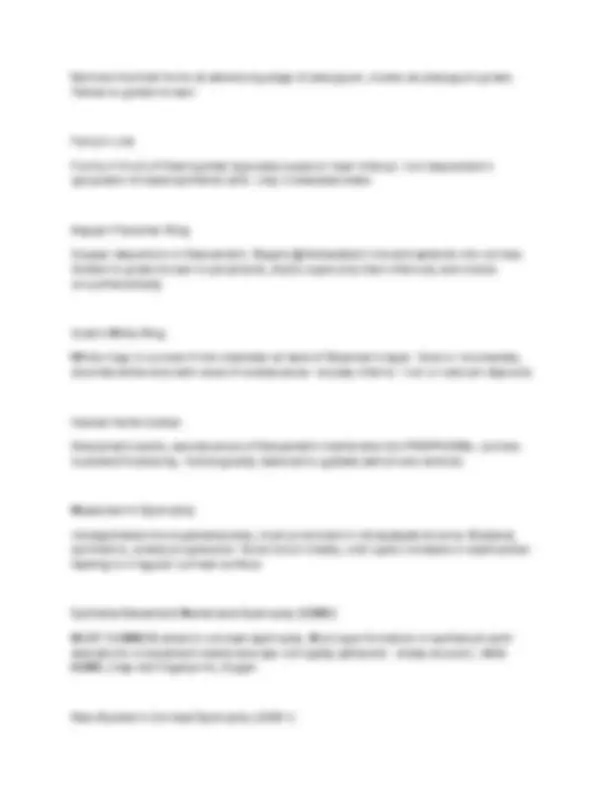
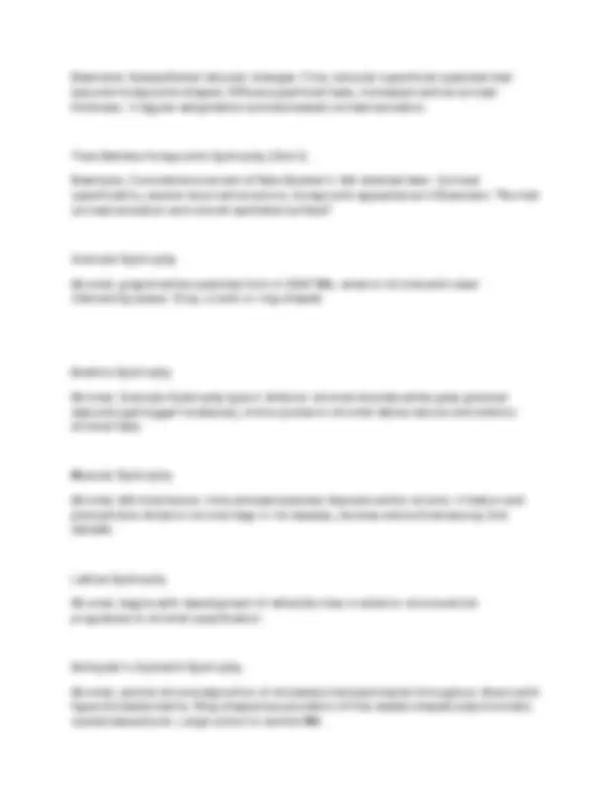
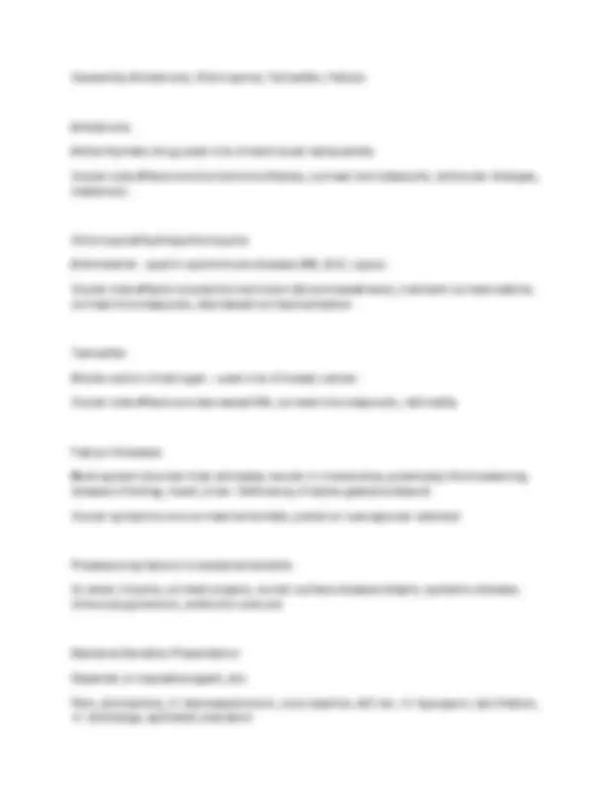
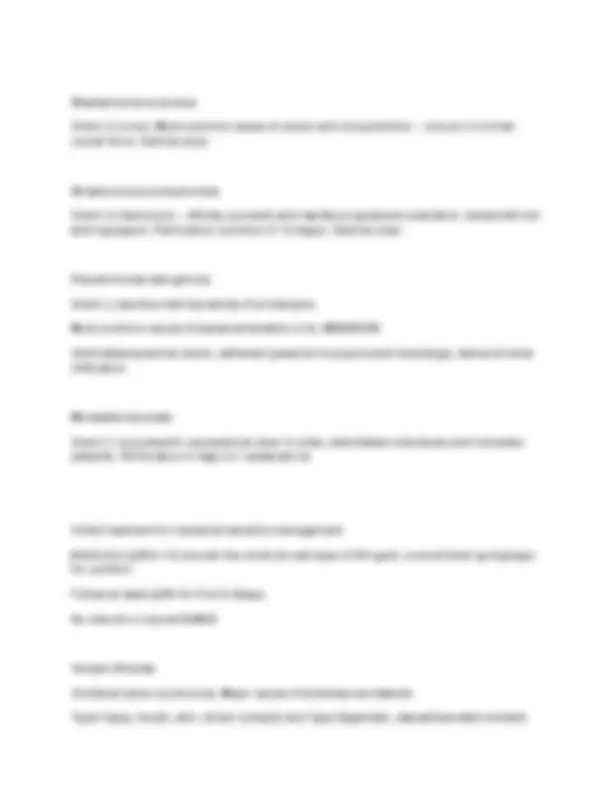
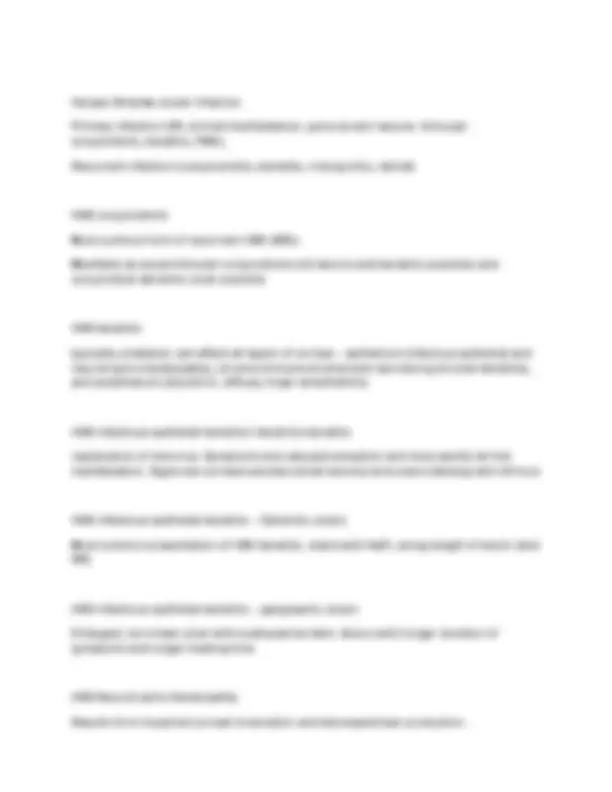



Study with the several resources on Docsity

Earn points by helping other students or get them with a premium plan


Prepare for your exams
Study with the several resources on Docsity

Earn points to download
Earn points by helping other students or get them with a premium plan
Community
Ask the community for help and clear up your study doubts
Discover the best universities in your country according to Docsity users
Free resources
Download our free guides on studying techniques, anxiety management strategies, and thesis advice from Docsity tutors
A detailed overview of the eye's anterior segment, focusing on the cornea's innervation, epithelial layers, Bowman's layer, stroma, Dua's layer, Descemet's layer, and endothelium. It discusses corneal degenerations/dystrophies like arcus senilis, fish-eye disease, lipid/spheroidal/amyloid degeneration, Salzmann's, Terrien's, senile furrow degeneration, and limbal girdle of Vogt. Also covered are corneal lines/rings (Hudson-Stahli, Fleischer's, Stocker's, Ferry's, Kayser-Fleischer) and dystrophies (Meesmann's, epithelial basement membrane, Reis-Buckler's, Fuch's). Finally, it addresses keratoconus, pellucid marginal degeneration, and corneal effects of drugs like amiodarone, chloroquine, and tamoxifen.
Typology: Exams
1 / 13

This page cannot be seen from the preview
Don't miss anything!








Corneal Innervation
Derived from ciliary nerves that penetrate cornea in deep peripheral stroma, lose myelination shortly after entering cornea. Terminate in wing cells of epi
Cornea: Epithelium
surface layer, 55um, barrier function (block debris, bacteria, foreign), constantly regenerated + sloughed
Cornea: Bowman's Layer
Basement membrane, 5um, prevents forward corneal swelling
Cornea: Stroma
Majority of the cornea, 485um, strength + elasticity
Cornea: Dua's Layer
Newly discovered, 10-15um, Unknown fxn
Cornea: Descemet's Layer
basement membrane, 10um, health of endothelial cell
Cornea: Endothelium
Innermost layer, 5um = 1 cell thick, barrier pump maintaining appropriate corneal hydration
Arcus Senilis
Degenerative change involving deposition of lipid in peripheral cornea. Gray/white arc progresses into a ring with sharp peripheral border and diffused central border. Limbal intervening zone.
Fish-Eye Disease
LCAT deficiency -- progressive arcus which begins in adolescence. May result in complete opacification. Usually asymptomatic besides cosmesis.
Lipid Degeneration
Dense yellow-white opacity that may fan out with feathery edges. Deposits consist of cholesterol, fats, phospholipids. Two types: (primary + secondary)
Spheroidal Degeneration
Clear to yellow-gold spherules seen in subepithelium, within Bowmans, or in superficial corneal stroma. They may darken with age. Three types: (primary corneal involvement, corneal involvement 2^ to underlying, conj involvement)
Amyloid Degneration
Groups of proteins with starch-like characteristics. Stains with Congo Red, birefingence in polarized light, and dichromism in green light. Primary of secondary forms
Salzmann's Nodular Degeneration
Yellow-white to blue elevated lesions on cornea. Usually annular pattern in mid-periphery. Adjacent to corneal scars or pannus. F>>M.
Terrien's Marginal Degeneration
Non-inflammatory peripheral thinning with pannus. White/grey band 1-2mm that starts superonasally and spreads circumferentially. A gutter forms between opacity and limbus (depression)
Vertical line that forms at advancing edge of pterygium, moves as pterygium grows. Yellow to golden brown.
Ferry's Line
Forms in front of filtering bleb (typically superior near limbus). Iron deposited in cytoplasm of basal epithelial cells. only in elevated blebs
Kayser-Fleischer Ring
Copper deposition in Descemet's. Begins @ Schwalbe's line and extends into cornea. Golden to green-brown in peripheral, starts superiorly then inferiorly and moves circumferentially
Coat's White Ring
White rings in cornea <1mm diameter at level of Bowman's layer. Oval or incomplete, discrete white dots with area of coalescence. Usually inferior. Iron or calcium deposits
Hassel-Henle bodies
Descemet's warts, excrescence of Descemet's membrane into PERIPHERAL cornea - localized thickening. Histologically identical to guttata (which are central)
Meesmann's Dystrophy
intraepithelial microcysts/vesicles, most prominent in intrapalpebral zone. Bilateral, symmetric, slowly progressive. Good vision initally, until cysts increase in size/number leading to irregular corneal surface
Epithelial Basement Membrane Dystrophy (EBMD)
MOST COMMON anterior corneal dystrophy. Microcyst formation in epithelium with alterations in basement membrane (epi not tightly adherent - slides around.). AKA ABMD, map-dot-fingerprint, Cogan.
Reis-Buckler's Corneal Dystrophy (CDB 1)
Bowmans; Subepithelial reticular changes. Fine, reticular superficial opacities that become honeycomb-shaped. Diffuse superficial haze, increased central corneal thickness. Irregular astigmatism and decreased corneal sensation
Thiel-Behnke Honeycomb Dystrophy (Cbd II)
Bowmans; Considered a variant of Reis-Buckler's. VA retained later. Corneal opacificatino, severe recurrent erosions, honeycomb appearance in Bowmans. Normal corneal sensation and smooth epithelial surface
Granular Dystrophy
Stromal; grayish white opacities form in CENTRAL anterior stroma with clear intervening space. Drop, crumb or ring-shaped.
Avellino Dystrophy
Stromal; Granular Dystrophy type 2. Anterior stromal discrete white-grey granular deposits (get bigger+coalesce), mid-to-posterior stromal lattice lesions and anterior stromal haze
Macular Dystrophy
Stromal; AR inheritance. Intra-and-extracellular deposits within stroma. Irritation and photophobia. Anterior stroma hazy in 1st decade, involves entire thickness by 2nd decade.
Lattice Dystrophy
Stromal; begins with development of refractile lines in anterior stroma which progresses to stromal opacification
Schnyder's Crystallin Dystrophy
Stromal; central stroma deposition of cholesterol+phospholipids throughout. Assoc with hypercholesterolemia. Ring shaped accumulation of fine needle shaped polychromatic crystal depositions. Large cohort in central MA.
(worse in AM)
Congenital Hereditary Endothelial Dystrophy (CHED)
AR and AD; bilateral and symmetric. Noninflammatory corneal clouding that extends to limbus without clear zones. No other anterior segment anomalies.
Keratoconus
Progressive thinning and protrusion of cornea leading to conical shape. Bilateral, often asymmetric, onset around puberty. Pt notices distortion.
Pellucid Marginal Degeneration
Band of corneal thinning 1-2mm typically in inferior. Max corneal protrusion usually just superior to area of thinning (normal thickness). "Kissing Doves"
Keratoglobus
Globular cornea which leads to high myopia and astigmatism. Cornea clear, normal size to slightly large. Stroma diffusely thinned 1/3 to 1/5 normal thickness, more pronounced in mid-peripheral
Posterior Keratoconus
Thinning due to increased curvature of posterior cornea; normal anterior curvature. Guttata occasionally within lesion, and pigment occasionally present at edge of lesion. Mild to moderate corneal astigmatism. Generalized or focal (more common).
Congenital Anterior Staphyloma
Bulging, opaque cornea lined with uveal tissue that protrudes beyond normal plane of lids. Variable thinning. Deep, disorganized anterior chamebr.
Corneal Verticillata
AKA corneal whorls -- whorl-like pattern of powdery, white, yellow or brown corneal epithelial deposits
Caused by Amidarone, Chloroquine, Tamoxifen, Fabrys
Amidarone
Antiarrhymatic drug used in tx of ventricular tachycardia.
Ocular side effects are blurred vision/haoes, corneal microdeposits, lenticular changes, madarosis.
Chloroquine/Hydroxychloroquine
Antimalarial - used in autoimmune disease (RA, SLE, lupus).
Ocular side effects include blurred vision (Accom weakness), transient corneal edema, corneal microdeposits, decreased corneal sensation
Tamoxifen
Blocks action of estrogen - used in tx of breast cancer.
Ocular side effects are decreased VA, corneal microdeposits, retinoathy
Fabry's Diseases
Multi-system disorder that ultimately results in irreversible, potentially life threatening disease of kidney, heart, brain. Deficiency of alpha-galactosidase A.
Ocular symptoms are corneal verticillata, posterior subcapsular cataract
Predispsoing factors to bacterial keratitis
CL wear, trauma, corneal surgery, ocular surface disease (bleph), systemic disease, immunosuppression, antibiotic overuse
Bacterial Keratitis Presentation
Depends on causative agent, etc.
Pain, photophbia, +/- decreased vision, conj injection, AC rxn, +/- hypopyon, lacrimation, +/- discharge, epithelial ulceration
Herpes Simplex ocular infection
Primary infection (6% clinical manifestation; perioral skin lesions; follicular conjunctivits, keratitis, PAN);
Recurrent infection (conjunctivitis, keratitis, iridocyclitis, retinal)
HSV conjunctivitis
Most common form of recurrent HSV (83%).
Manifests as acute follicular conjunctivitis (lid lesions and keratitis possible) and conjunctival dendritic ulcer possible
HSV keratitis
typically unilateral; can affect all layers of cornea -- epithelium (infecious epithelial and neurotrophic keratopathy), stroma (immune stromal and necrotizing stromal keratitis), and endothelium (disciform, diffuse, linear endotheliitis)
HSV infectious epithelial keratitis / dendritic keratitis
reactivation of live virus. Symptoms are reduced sensation and most painful at first manifestation. Signs are corneal vesicles (small lesions) and ulcers devleop w/in 24 hour
HSV infectious epithelial keratitis -- Dendritic ulcers
Most common presentation of HSV keratitis; stains with NaFL along length of lesion (and RB)
HSV infectious epithelial keratitis -- geographic ulcers
Enlarged, non-linear ulcer with scalloped borders. Assoc with longer duration of symptoms and longer healing time.
HSV Neurotrophic Keratopathy
Results form impaired corneal innervation and decreased tear production.
Presents w/ corneal irregularity, oval shaped epi defect w/ smooth border.
HSV Stromal Keratitis
20-48% of recurrent disease.
Primary involvement (necrotizing stromal keratitis and immune stromal keratitis); and secondary involvement (sequelae of epi, neurotrophic and endo infection)
HSV necrotizing stromal keratitis
rare, direction invasion of cornea
Presents with necrosis (severe), dense stromal infiltration with overlying epi defect; thinning+perforation possible.
HSV Immune stromal (interstitial) keratitis
is seen in 20% of recurrent HSV. This stromal inflammation is caused by retained viral antigen in the stroma.
This presents as a stromal infiltration and inflammation, an immune ring, and neovascularization in the stroma.
It occurs days to years following infectious epithelial keratitis.
Gradual progression of inflammation through the stroma can lead to corneal perforation.
HSV Endotheliitis
Immune response to viral antigen; features: stromal and epithelial edema without infiltrate, KPs and iritis.
3 types: disciform, diffuse, and linear
HSV Disciform Endothelitis
Most common presentation of the endothelitis: round lesion.
Limbal injection, ring-shaped regions of stromal edema, overlying microcystic edema, iritis, raised IOP
keratoneuritis, photophobia, uveitis.